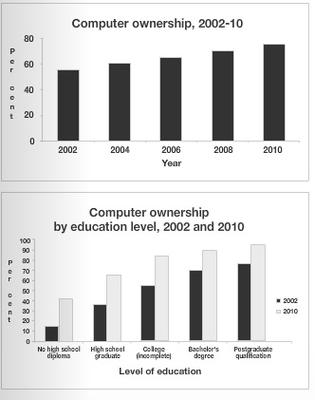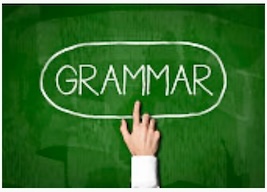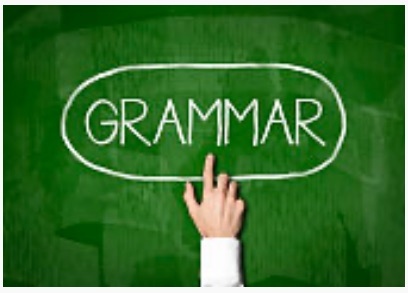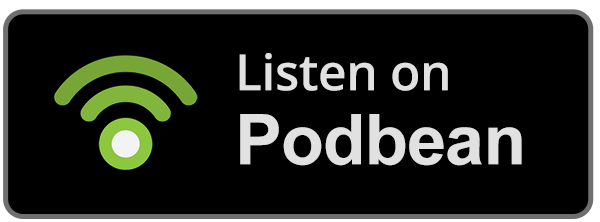IELTS Bar Chart - Computer Ownership
by novita
(indonesia)

The graphs above give information about computer ownership as a percentage of the population between 2002 and 2010, and by level of education for the years 2002 and 2010.
Hi, may i please have a feedback on my ielts writing below? any suggestion is a huge help. thank you.
Computer ownership increases significantly from the year 2002 until 2010. The graph shows in the beginning, roughly sixty - percent of the population owns a computer. By the year 2010 this number has almost double in size with an eighty-percent of the population then owns a computer. The graph also shows that there is a constant positive trend of computer ownership during those years leaving only twenty- percent of the population which does not yet own a computer by the end of 2010.
The education level of the population also affects the number of computer ownership. The later the year, the more people goes to school, the more graduates are emerged, hence the higher they are at their level of education. From the graph, a population with a higher level of education tends to own more computers than the slightly less educated population. However, the increase of computer ownership over the years is particularly evident accross all range of education regardless the education level.
Comments for IELTS Bar Chart - Computer Ownership
|
||
|
||
|
||
|
||
IELTS Computer Ownership Graph
by Khuntheng Puthirithea
(Siem Reap, Cambodia)
Initially, I have lacked acquirement of writing and now I am getting my hands dirty on this operation day by day. Therefore, befall, I decide to send one of my practice through the site in order to receive feedback.
Finally, I am looking forward to receiving feedback from the site.
Thanks in advance!
The graphs above give information about computer ownership as a percentage of the population between 2002 and 2010, and by level of education for the years 2002 and 2010.
Summarise the information by selecting and reporting the main features, and make comparisons where relevant.
Write at least 150 words.
The bar graphs provide data of computer ownership as percentage of population from 2002 to 2010 and by various level of education in the years 2002 and 2010.
According to the first graph, it illustrates that in 2002 there were approximately 56% of people who owned computer and it rose gradually from around 56% in 2002 to well-over 60% in 2008.Furthermore , it increased very slowly and reached its peak in 2010 from well-over 60% to considerably 74%.
Base on the following figure , in 2002 it indicates that there were about 13% of computer users who had no high school diploma and this was triply less than students who had completely graduated from high school whose proportion was hovering 30% of computer users. Meanwhile,in 2002, the proportion of postgraduate qualifiers was the maximum, which was approximately 75%;followed by Bachelor's degree qualifiers and incomplete college students: around 70% and slightly under 60%,respectively.However, it is suggested that the in 2010 these groups maintained very similar around 85% to 95% of users as the postgrauate qualifiers still were the most users like they were in 2002.
Overall, there were an increasingly onward of computer owners from 2002 to 2010; while 5 different level of students ,their computer using rates altered significantly and increasingly in 2002 and 2010.
Comments for IELTS Computer Ownership Graph
|
||
|
||
|
||
|
||
Bar Chart - Computer Ownership and Level of Education
by rifa
(Indonesia)
The charts show computer ownership from 2002 – 2010 and computer ownership by education level in 2002 and 2010. Generally, there were increased number of ownership from 2002 to 2010 and the percentage were higher along with higher education level.
From the first chart, the ownership of computer were between about 50% to 70%. Its percentage is increased slightly every two years and reached its peak in 2010 which more than 60%.
The second chart shows above 10% people without high school diploma in 2002 owned computer. The biggest percentage at the same year is in postgraduate qualification which almost 80%. Furthermore, computer ownership in each level education increased from 2002 and 2010. The difference between these two years were quite the same in three education level; no high school diploma, high school graduate, and college which 30% higher. On the other hand, the difference in bachelor and postgraduate degree were only about 20%.
You can give comment's on this student's response to this Task 1 below.
Computer Ownership Graph
by Huy
(Ha Long, Quang Ninh, Viet Nam)

The graphs give information about computer ownership as a percentage of the population between 2002 and 2010, and by level of education for the years 2002 and 2010.
Can someone evaluate my writing pls?
The graphs illustrate the proportion of people who owned computers of the population and by educational qualifications in 2002 and 2010. Units are measured in percent.
Overall, there was an upward trend in this period of time. However, the lowest values still belong to the no high school diploma group and the highest for the people who had postgraduate qualifications. The disparity is between two years inversely ratio to the levels of education.
There were about 58% of the population owned computers in 2002. In particular, people with no certificate only occupied about 15% in total. Whereas, postgraduate students inhabited three out of four in approximate.
The percentage in 2002 increased gradually in nine year until it peaked at slightly under 80% in 2010, which means it had increased approximately 20%. Although no high school diploma people were still at the bottom of a chart, the number had increased dramatically to just over 14%. At the same time, the postgraduate qualification group reached around 95% totality. The difference between two groups of people has decreased for approximately 20%.
IELTS Graph - Computer ownership
by Liza
(Moscow)
Hello everyone,
here's an IELTS Academic Writing 1 assignment I have written today. I would really appreciate if anyone could comment on this and especially tell me whether it could be given a good mark (6.5 or higher)? Thank you in advance!
(test from the site of British Council)
The graphs below give information about computer ownership as a percentage of the
population between 2002 and 2010, and by level of education for the years 2002 and
2010.
Summarise the information by selecting and reporting the main features, and make
comparisons where relevant.
------------------------------------------------------------------------
The 2 bar graphs illustrate the data about how many people owned a computer in years 2002-2010, as well as illustrating the correlation between owning a computer and having a certain level of education.
According to the data, there had been a steady rise in the amount of computer owners over the period of eight years. It went up from just 55% (that is, roughly a half) of the total population to 75% in 2010, that is, rose by 20%.
As for the educational level of computer owners, here the changes seem to be more dramatic. 5 different levels had been taken into account, from those with no high school diploma to those having a postgraduate qualifications. While in the year 2002 only 15% of the first had a computer, the percentage had tripled by the year 2008, reaching 45%. Those with a postgraduate degree in both 2002 and 2008 accounted for the highest percent of computer ownership, but the difference between the two years is less impressive, as it went from 75% to 95%, thus covering almost all people with such a degree. Computers also gained popularity among the rest of the population, namely those who had completed high school, college and those with a bachelors degree. With each of those levels computer ownership increases in both 2002 and 2010.
To sum up up, there are several trends to be mentioned. Along with a steady growth of computer ownership among the population, there is a link between owning a computer and having a particular educational level as the higher the latter is among those people whose data had been collected, the more probable it is that they have a computer.
Computers
by flower
(India)
The first bar diagram illustrates the percentage of people that own a computer from 2002 until 2010, while the second bar chart shows those who possess computer according to their educational qualifications.
Overall, there was a gradual increase in the number of people that owned computers since the beginning of 2002. As people pursue higher education their usage of a computer was also proportionately correlated.
In 2002, more than 50% of people were using their computers for various groups. This number steadily increased in 8 years and reached up to almost 75% people were using their computers by 2010.
The usage of computer was eminent by postgraduate student in 2002 as well as in 2010. On the other hand, people that does not have high diploma was the least number of people that owned computers in 2002 with approximately 15%. However, by 2010, this number was tripled that owned computers.
Computer Ownership
by Kunal
(India)

The graphs above give information about computer ownership as a percentage of the population between 2002 and 2010, and by level of education for the years 2002 and 2010.
Hey everyone just want a little help from you guys to please kindly give me feedback on report writing task 1 on computer ownership.
Here is the report....
The diagram represents data regarding computer ownership as a percentage of different masses of people between the years 2002 and 2010 and by education level for the time of 8 years.
First of all, the computer ownership has been constantly increasing over the time period between 2002 and 2010. As the percentage increased from 58 percent to 70 percent.
Secondly, observing the different types of degrees and diplomas computer ownership by level of education in which the year 2010 dominated the 2002 in every degree and short term course. Focusing on no high school diploma, it was found that there was substantial difference in percentage as in 2002 it was about 12 percent which rose to 40 percent in next 8 years.
In the last, year 2010 was always leading completely with the year 2001 in various level of education with reaching maximum of 90 percent in postgraduate qualification in contrast to 2002 which only reached a highest of 72 percent.
Computer Ownership Bar Graph
by Bayan
The given bar chart displays the proportion of people who have computers over the course of eight years, from 2002 to 2010. It also compares between the first year and the last year of the same period in the computer ownership with the relationship to the education level.
Overall, computer ownership had increased gradually from over 55% in 2002 to around 80% in 2010. In addition, the percentage of people with higher education level is more than those with lower level.
Computer ownership has increased by 20% during eight years. The period begins with over 55% of people who own computer, and then the percentage increased to less than 70% at the middle of the period before reaching around 80% at the end. In comparison to the education level, the percentage of people with no high education diploma who having computer in 2010 grew threefold more than in 2002. The rate of high school graduates and college students who own computer in 2010 rose by 20%. The percentage of rest of who have higher degrees and own computers saw a slight increase compared to other levels, but remains the highest percentage of around 90%.
IELTS Bar Chart - Owned Computers by Education Level
by Anon
Could you give me the comments on my writing task 1?
The bar charts below illustrate how many people owned computers by education level from 2002 to 2021.
Overall, the percentage of computer users increase gradually over the period. In addition, the more educated people got, the more computers they owned. Moreover, regardless of education level, the proportion of people using a computer in 2010 was always higher than the figure in 2002.
About over 50% of the population owned a computer in 2002, with a significant rise to nearly 80% of people. In 2002, there was only 15% of people who had not finished high school owned computers, but this figure trebled in 2020 to approximately 45%. Similarly, the percentage of students who finished high school saw a double from 35% to 70% over the period.
There was moderate growth in the proportion of both post-graduated and after graduated students throughout the period from 50% to 80% and 65% to 85% respectively. The figure for postgraduate qualification students remained the highest figure in 8-year-period and witnessed a slight increase from 70% in 2002 to over 90% in 2010.
IELTS Bar Chart - Education Related Computer Ownership
by Neel
(India)

The graphs give information about computer ownership as a percentage of the population between 2002 and 2010, and by the level of education for the years 2002 and 2010.
Task 1
(I would appreciate any and all constructive criticism)
The bar charts above depict trends in computer ownership in a population as a percentage, in relation to education level, from 2002 to 2010. The charts show a clear trend of computer ownership increasing over the span of 8 years, with postgraduates being the largest group of computer owners and non-high school graduates being the smallest group of computer owners.
The first chart addresses computer ownership in relation to the entirety of the population. It displays ownership in percentages. Computer ownership was the lowest in 2002 where less than 60% of the population owned computers, but there was a positive trend which showed an increase in ownership, as by 2010 almost 80% of people owned computers. Computer ownership increased by almost 20% in the span of 8 years.
The second bar chart depicts computer ownership in relation to the level of education. There are 5 education levels in the chart: no high school diploma, high school graduate, incomplete college, bachelor’s degree holders and postgraduate qualifications.
It is shown that around 15% of high school dropouts, in 2002, own computers. However, in 2010 this number has increased exponentially to 40%.
A similar increase is observed in the coming categories as well, there was an almost 30% increase in high school graduates owning computers; 35% in 2002 to 65% in 2010.
In 2010 nearly 80% of college students owned computers, an estimated 25% increase from the 55% in 2002.
A little more than 70% of bachelor’s degree holders owned computers in 2002 but in 2010 almost 90% owned computers.
Postgraduates have always been the largest group of computer owners over the course of 8 years, and between 2002 and 2010 there was an increase of around 15% in computer owners, thus pushing the total percentage of computer owners in 2010, for this group, to almost 95%.
Word count: 304
Time taken to write: 17 minutes














